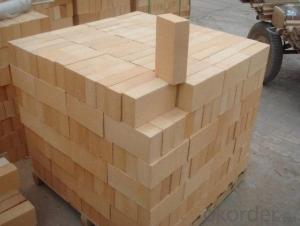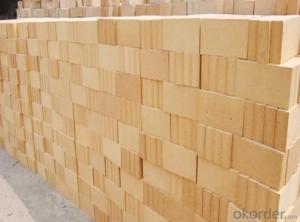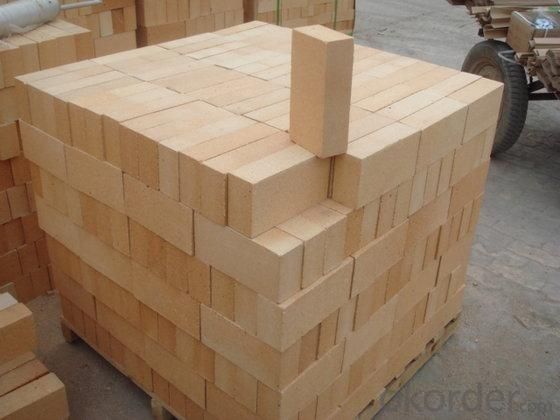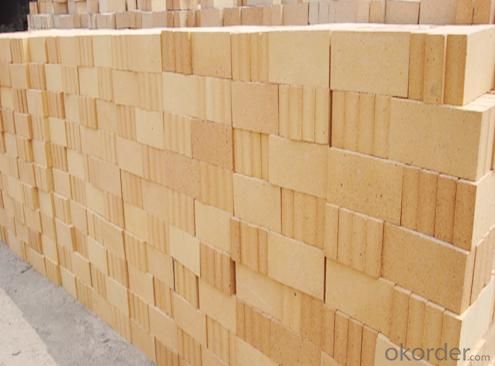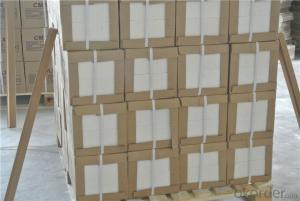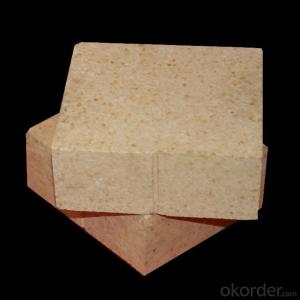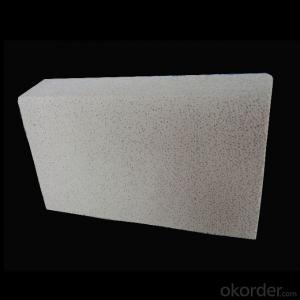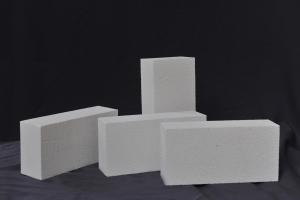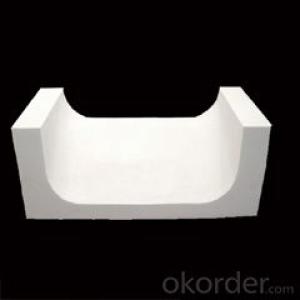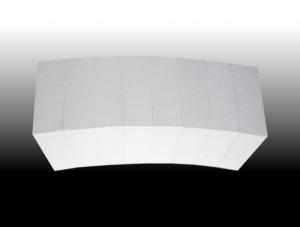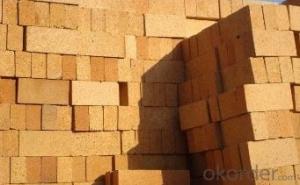Insulating Fire Brick - Refractoriness SK32 1710C for Clay Brick
- Loading Port:
- China main port
- Payment Terms:
- TT OR LC
- Min Order Qty:
- 50 m.t.
- Supply Capability:
- 5000 m.t./month
OKorder Service Pledge
OKorder Financial Service
You Might Also Like
CNBM conforms strictly to the requirements of ISO 9000 quality control system during the production. MSDS is also available if you want. The thermal insulation fire clay brick meet with the requirements of ASTM & JIS standards. So pls stay cool with our quality.
Insulating Fire Brick Technical index
Product No. | IFB70 | IFB60 | IFB50 | IFB40 |
Al2O3 | 68%-72% | 58%-62% | 48%-52% | 38%-40% |
Refractoriness (°C ) | ≥1790 | ≥1790 | ≥1790 | ≥1790 |
Bulk density (g/cm3) | 2.50-2.60 | 2.35-2.45 | 2.20-2.30 | 2.10-2.20 |
Apparent porosity (%) | 22 | 19-22 | 17-20 | 17-20 |
Cold Crushing strength (kg) | 480-510 | 450-480 | 430-450 | 390-430 |
Application
Insulating Fire Brick are used for the lining of converter, alternating current arc furnace, direct Current arc furnace and the ladle slag line, etc.
Equipment
1 unit of Ceramic Abrasive (SG Abrasive) pilot production line
2 units of Compact grain Abrasive pilot production lines
1 unit of high-end coated abrasives (abrasive cloth) production line
Company Advantage
(1)Long Insulating Fire Brick manufacture history: 25 years manufacturer
(2)Advanced equipment
(3)Diversification of production standards: ISO ANSI FEPA JIS ASTM
(4)Flexible payment: T/T L/C D/P D/A
(5)Professional marketing team and after-sale service
(6)Free sample
FAQs
Q1 |
What’s the transport method? |
A1 | FCL delivery goods with wooden pallet or wooden case by sea; If LCL delivery, must with wooden case; Sometimes need open top, flat rack or bulk cargo. |
Q2 |
What’s the required payment term? |
A2 | Generally 30% TT as the prepayment, 70% TT before delivery. If need, 100% Irrevocable Letter of Credit or negotiation. |
Q3 |
Which country are our products exported to? |
A3 | Apart from entire Chinese market, the US, Russia, Japan, Korea, Australia and some Southeast Asian Nations. |
- Q: Refractory bricks, burner bricks, insulation bricks? Is it a kind of thing?
- Not the same thing, refractory bricks and insulation bricks of raw materials, the proportion is not the same. This is the chain of various types of products
- Q: Can insulating fire bricks be used in waste incineration plants?
- Insulating fire bricks are indeed applicable in waste incineration plants. Their ability to endure high temperatures renders them suitable for the exceedingly hot surroundings found in these plants. These bricks are crafted from lightweight materials that possess exceptional thermal insulation properties, thus aiding in minimizing heat loss and enhancing energy efficiency during the incineration procedure. Moreover, insulating fire bricks exhibit commendable resistance to both chemical and thermal shock, a crucial attribute in waste incineration plants where diverse waste materials are combusted. Overall, the incorporation of insulating fire bricks in waste incineration plants contributes to heightened insulation, increased energy efficiency, and enhanced incineration process performance.
- Q: What are insulation bricks for? Do not use high-rise buildings on the ah?
- Buildings usually do exterior thermal insulation, such as EPS board, polyphenyl board and so on
- Q: Can insulating fire bricks be used in smelting furnaces?
- Yes, insulating fire bricks can be used in smelting furnaces. Insulating fire bricks are designed to have low thermal conductivity, which helps to conserve heat and maintain high temperatures inside the furnace. This makes them an ideal choice for smelting furnaces where high temperatures are required. Additionally, insulating fire bricks also have a high resistance to thermal shock, which means they can withstand rapid temperature changes without cracking or breaking. This is particularly important in smelting furnaces where the temperature can fluctuate significantly. Overall, insulating fire bricks are an excellent option for smelting furnaces as they help to improve energy efficiency, reduce heat loss, and provide durability in high-temperature environments.
- Q: Do insulating fire bricks require any special sealing or caulking?
- Yes, insulating fire bricks typically require special sealing or caulking in certain applications. While insulating fire bricks are designed to withstand high temperatures and provide excellent thermal insulation, they can still be susceptible to moisture infiltration and atmospheric gases in specific environments. To mitigate these risks, sealing or caulking is often necessary. Sealing or caulking insulating fire bricks involves using specialized refractory materials or compounds that are resistant to high temperatures and can create an airtight barrier. The sealing process helps to prevent the ingress of moisture, gases, or other contaminants that could compromise the insulating properties of the bricks. The specific sealing or caulking method will depend on the application and the type of insulating fire bricks being used. Some common sealing techniques include using high-temperature silicone sealants, refractory mortars, or coatings. These materials are specifically formulated to withstand the extreme temperatures experienced in high-heat environments. It is important to consult the manufacturer's guidelines or seek professional advice when determining the appropriate sealing or caulking method for insulating fire bricks. Proper sealing ensures the longevity and effectiveness of the insulation, as well as the overall performance and safety of the application.
- Q: Can insulating fire bricks be used in thermal insulation panels?
- Yes, insulating fire bricks can be used in thermal insulation panels. Insulating fire bricks are made from lightweight materials such as clay, alumina, and silica, which have excellent thermal insulation properties. These bricks are designed to withstand high temperatures and provide insulation in various applications, including furnaces, kilns, and industrial equipment. When used in thermal insulation panels, insulating fire bricks can help reduce heat transfer and improve energy efficiency. They can effectively trap and reflect heat, preventing it from escaping or entering the insulated area. This makes them suitable for insulating walls, roofs, and other structures where thermal insulation is required. Moreover, insulating fire bricks are easy to install and can be cut or shaped to fit different spaces and configurations. This flexibility allows for customization and ensures a tight and efficient insulation barrier. It is worth noting that while insulating fire bricks provide excellent thermal insulation, they may not be as effective in sound insulation. Therefore, if soundproofing is also a requirement, additional soundproofing measures may need to be taken. Overall, insulating fire bricks are a reliable choice for thermal insulation panels, offering high insulation performance, durability, and versatility.
- Q: Is it possible to recycle broken insulating fire bricks?
- Yes, it is possible to recycle broken insulating fire bricks. These bricks can be crushed and used as aggregate in the production of new bricks or other construction materials. Additionally, they can be ground into a fine powder and used as a raw material in the manufacturing of refractory products. Recycling broken insulating fire bricks helps reduce waste and conserve resources.
- Q: Can insulating fire bricks be used in the construction of melting furnaces?
- Yes, insulating fire bricks can be used in the construction of melting furnaces. Insulating fire bricks are designed to withstand high temperatures and have excellent thermal conductivity. They are specifically engineered to reduce heat loss and conserve energy, making them ideal for use in melting furnaces. In addition, insulating fire bricks are lightweight and easy to handle, making them convenient for construction purposes. They can effectively retain heat and maintain a stable temperature within the furnace, ensuring efficient melting and casting processes. Furthermore, insulating fire bricks are resistant to chemical corrosion and mechanical stress, making them durable and reliable for long-term use in melting furnaces. Overall, insulating fire bricks are a suitable choice for constructing melting furnaces due to their thermal properties, ease of use, and durability.
- Q: Are insulating fire bricks resistant to hydrofluoric acid vapors?
- Insulating fire bricks are generally not resistant to hydrofluoric acid vapors. Hydrofluoric acid is a highly corrosive substance that can attack and dissolve a wide range of materials including many types of bricks. Insulating fire bricks are designed to withstand high temperatures and provide thermal insulation, but they are not specifically designed to resist chemical attacks. Therefore, it is important to exercise caution when using insulating fire bricks in environments where hydrofluoric acid vapors are present, as they may deteriorate or degrade over time. It is advisable to consult with the manufacturer or a chemical engineer to determine the best materials for handling hydrofluoric acid vapors.
- Q: Do insulating fire bricks have a low thermal conductivity?
- Yes, insulating fire bricks have a low thermal conductivity.
Send your message to us
Insulating Fire Brick - Refractoriness SK32 1710C for Clay Brick
- Loading Port:
- China main port
- Payment Terms:
- TT OR LC
- Min Order Qty:
- 50 m.t.
- Supply Capability:
- 5000 m.t./month
OKorder Service Pledge
OKorder Financial Service
Similar products
Hot products
Hot Searches
Related keywords

